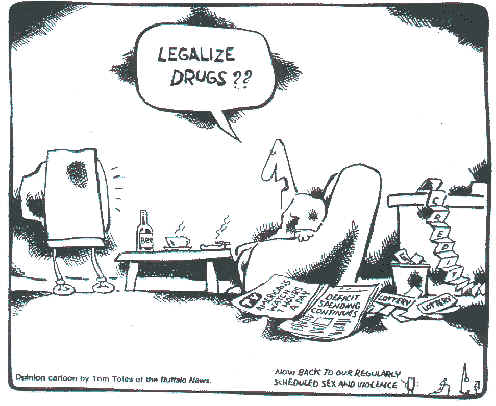
Advanced Composition
Editorial Cartoon
We will write several of these brief papers on editorial cartoons or other graphics during the course. There is a cartoon at the bottom of this page. Look at it quickly, then read the instructions here, then go back and examine the cartoon carefully and write the paper. It should be from 500-750 words.
Editorial Cartooning: Unlike the comics on the "funny pages," political or editorial cartoons have, for well over a century, been a respected means for expressing opinions on events, personalities, and issues in the public debate. Today a Pulitzer Prize is awarded annually for Editorial Cartooning. Such cartoons are not meant primarily to entertain or to generate humor. Rather, their purpose is to make pointed commentaries on subjects of public interest in an interesting and arresting manner. Thus, they appear on the editorial pages of newspapers, magazines, and other publications rather than in pages devoted to entertainment.
Generally we think of editorials as being text, but the political cartoon makes its editorial comment with a graphical display, primarily with pictures, usually including some text either as a caption or as dialogue. The effective cartoonist provides enough information in the cartoon to give the viewer a clear idea of the subject or issue and what the view on that subject the cartoonist has. The cartoonist has a topic and a thesis. In other words, the cartoon provides the answers to the questions, "What’s the topic?" and "What’s the point?"
The Essay: For this essay, your task is to define the topic and the point of a political cartoon. You will write an essay explaining the point of the cartoon and how the cartoon expresses the opinion of the cartoonist—What does the cartoon "say"? How does it "say" it? Having done that basic task, the most effective essays may go beyond those minimum expectations and provide some commentary and context for the discussion. That is, having defined the position of the cartoonist, you may want to define your own position on the subject and support and explain that.
There are some minimum expectations for the essay itself. It should have a title. It should begin with an introduction that generates interest and identifies your topic. It should make a clear statement of your thesis (for example, "The cartoonist suggests that people don’t care as much as they claim to about violence in the media.") It should include a detailed description of the cartoon in order to support your thesis. It should mention the name of the cartoonist. If you include your own views on the subject, they should appear separate from the description and not detract from it. The ending should provide a sense of closure. The essay should have few, if any, grammatical or mechanical errors. The best essays will show evidence of planning and display a variety of sentence types and a careful attitude about word choice and phrasing.
Assume that your audience is a general reader who has not seen the cartoon. Begin by examining the cartoon carefully and making notes on what you plan to cover in the essay. Make a plan! Keep it between 500 and 750 words.
Write the essay in the word processor, save it to your hard drive, and copy the essay into an email message to me (no attachments) before midnight.
Home Page | Schedule | Nelson's Home Page | Email Nelson | Pluto | Discussion Board | Mundt Library | Tutorial